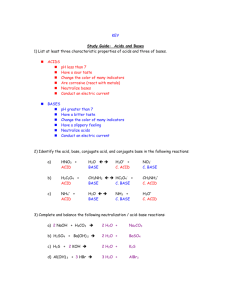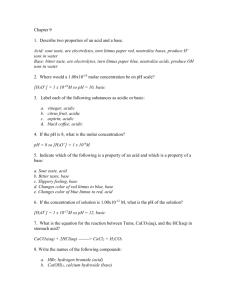Unit 5: Acids & Bases Answers
advertisement
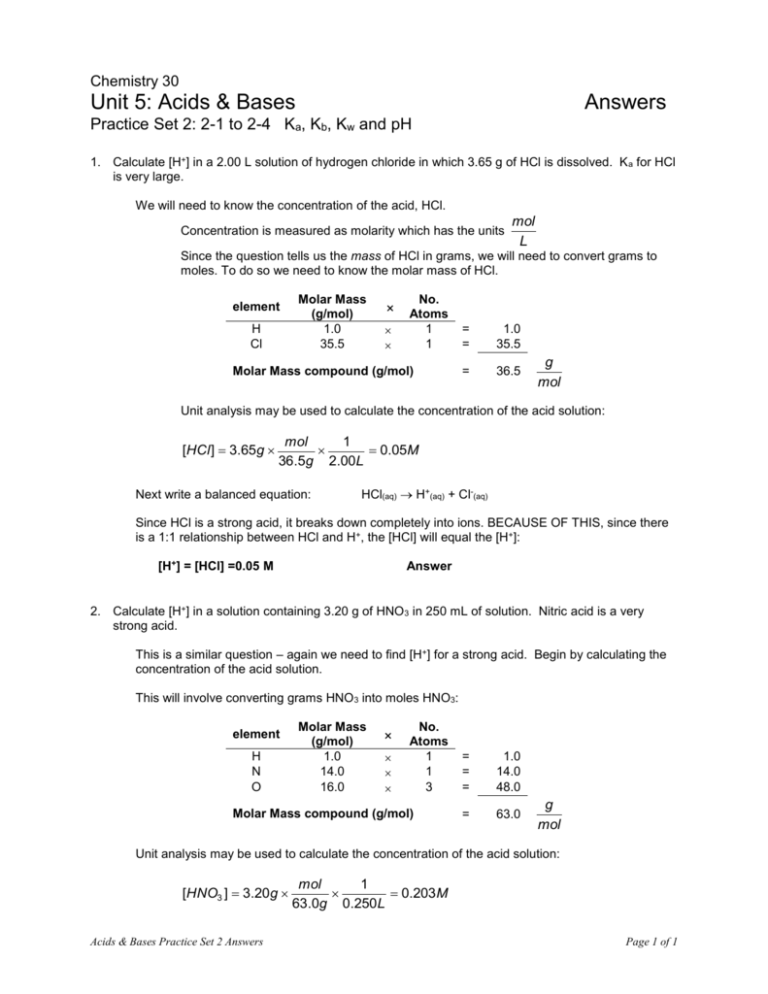
Chemistry 30 Unit 5: Acids & Bases Answers Practice Set 2: 2-1 to 2-4 Ka, Kb, Kw and pH 1. Calculate [H+] in a 2.00 L solution of hydrogen chloride in which 3.65 g of HCl is dissolved. K a for HCl is very large. We will need to know the concentration of the acid, HCl. Concentration is measured as molarity which has the units mol L Since the question tells us the mass of HCl in grams, we will need to convert grams to moles. To do so we need to know the molar mass of HCl. element H Cl Molar Mass (g/mol) 1.0 35.5 No. Atoms 1 1 Molar Mass compound (g/mol) = = 1.0 35.5 = 36.5 g mol Unit analysis may be used to calculate the concentration of the acid solution: [HCl ] 3.65g mol 1 0.05M 36.5g 2.00L Next write a balanced equation: HCl(aq) H+(aq) + Cl-(aq) Since HCl is a strong acid, it breaks down completely into ions. BECAUSE OF THIS, since there is a 1:1 relationship between HCl and H+, the [HCl] will equal the [H+]: [H+] = [HCl] =0.05 M Answer 2. Calculate [H+] in a solution containing 3.20 g of HNO3 in 250 mL of solution. Nitric acid is a very strong acid. This is a similar question – again we need to find [H+] for a strong acid. Begin by calculating the concentration of the acid solution. This will involve converting grams HNO3 into moles HNO3: element H N O Molar Mass (g/mol) 1.0 14.0 16.0 No. Atoms 1 1 3 Molar Mass compound (g/mol) = = = 1.0 14.0 48.0 = 63.0 g mol Unit analysis may be used to calculate the concentration of the acid solution: [HNO3 ] 3.20g Acids & Bases Practice Set 2 Answers mol 1 0.203M 63.0g 0.250L Page 1 of 1 HNO3(aq) H+(aq) + NO3-(aq) Next write a balanced equation: Since HNO3 is a strong acid, it breaks down completely into ions. BECAUSE OF THIS, since there is a 1:1 relationship between HNO3 and H+, the concentration of HNO3 will equal the concentration of H+: [H+] = [HNO3] =0.203 M Answer 3. An acetic acid (HC2H3O2) solution is 0.25 M. Given that Ka for acetic acid is 1.8 10-5, find [H+]. The question gives us the concentration of the acid (0.25 M), so we may begin by writing a balanced equation. We need this in order to set up the Ka expression. HC2H3O2 (aq) H+(aq) + C2H3O2-(aq) Because this is a weak acid, [H+] WILL NOT EQUAL [HC2H3O2]. We will need to use the Ka expression to find [H+]: [H ][C 2 H 3O2 ] [HC2 H 3O2 ] Set up the equation based on the balanced equation: Ka Substitute in known values, and let the unknown values = x: 1.8 10 5 Rearrange the equation x2 = (1.8 10-5)(0.25) [ x ][ x ] [0.25] x2 = 4.5 10-6 Take the square root to find x: x2 = 4.5 10-6 x = [H+] = 2.1 10-3 also Answer [C2H3O2-] = 2.1 10-3 4. A solution of acetic acid contains 12.0 g of HC2H3O2 in 500 mL of solution. Calculate [H+]. We will need to know the concentration of the acid, HC2H3O2 Since the question tells us the mass of HC2H3O2 in grams, we will need to convert grams to moles. To do so we need to know the molar mass of HC2H3O2. element H C O Molar Mass (g/mol) 1.0 12.0 16.0 No. Atoms 4 2 2 Molar Mass compound (g/mol) Acids & Bases Practice Set 2 Answers = = = 4.0 24.0 32.0 = 60.0 g mol Page 2 of 2 Unit analysis may be used to calculate the concentration of the acid solution: [HC2 H 3O2 ] 12.0g mol 1 0.400M 60.0g 0.500L Next we need a balanced equation which will be needed in order to set up the Ka expression. HC2H3O2 (aq) H+(aq) + C2H3O2-(aq) Because this is a weak acid, [H+] WILL NOT EQUAL [HC2H3O2]. We will need to use the Ka expression to find [H+]. Ka for this acid was given in the previous question or can be found in the Table of Acid Strengths: [H ][C 2 H 3O2 ] [HC2 H 3O2 ] Set up the equation based on the balanced equation: Ka Substitute in known values, and let the unknown values = x: 1.8 10 5 Rearrange the equation x2 = (1.8 10-5)(0.400) [ x ][ x ] [0.400 ] x2 = 7.2 10-6 x2 = 7.2 10-6 Take the square root to find x: x = [H+] = 2.7 10-3 also Answer [C2H3O2-] = 2.7 10-3 5. Calculate [H+] and [OH-] at 25 C in: a. a 5.0 M NaOH solution. NaOH is a strong base. Begin with a balanced equation: NaOH (aq) Na+(aq) + OH-(aq) Since this is a strong base and there is a 1:1 ratio between NaOH and OH -, [OH-] = [NaOH] = 5.0 M first part of the answer Find [H+] using Kw: Kw = [H+][OH-] = 1.0 10-14 Rearrange this equation to find the unknown; in this case [H+]: [H ] Substitute in values and solve for [H+]: [H ] Kw [OH ] 1.0 10 14 [5.0] [H+] = 2.0 10-15 M Acids & Bases Practice Set 2 Answers Kw will always equal 1.0 10-14 answer Page 3 of 3 b. a 0.025 M Ca(OH)2 solution. Ca(OH)2 is a strong base. Begin with a balanced equation: Ca(OH)2 (aq) Ca2+(aq) + 2 OH-(aq) Since this is a strong base and there is a 1:2 ratio between Ca(OH) 2 and OH-, [OH-] = 2 [Ca(OH)2] = 2 0.025 = 0.050 M first part of the answer Find [H+] using Kw: Kw = [H+][OH-] = 1.0 10-14 Rearrange this equation to find the unknown; in this case [H+]: [H ] Substitute in values and solve for [H+]: [H ] Kw [OH ] 1.0 10 14 [0.050 ] [H+] = 2.0 10-13 M c. Kw will always equal 1.0 10-14 answer a 0.10 M HCl solution. HCl is a strong acid Begin with a balanced equation: HCl (aq) H+(aq) + Cl-(aq) Since this is a strong acid and there is a 1:1 ratio between HCl and H+, [H+] = [HCl] = 0.10 M first part of the answer Find [OH-] using Kw: Kw = [H+][OH-] = 1.0 10-14 Rearrange this equation to find the unknown; in this case [OH-]: [OH ] Substitute in values and solve for [OH-]: [OH ] Kw [H ] 1.0 10 14 [0.10] [OH-] = 1.0 10-13 M Kw will always equal 1.0 10-14 answer d. a 0.01 M HC2H3O2 solution. HC2H3O2 is a weak acid with Ka = 1.8 10-5. Because this is a weak acid, we need to do some calculations in order to determine [H +]. But we still begin with a balanced equation: HC2H3O2 (aq) H+(aq) + C2H3O2-(aq) We need to set up the Ka equation in order to find [H+] for this weak acid: Acids & Bases Practice Set 2 Answers Page 4 of 4 [H ][C 2 H 3O2 ] [HC2 H 3O2 ] Set up the Ka equation based on the balanced equation: Ka Substitute in known values, and let the unknown values = x: 1.8 10 5 Rearrange the equation x2 = (1.8 10-5)(0.010) [ x ][ x ] [0.010] x2 = 1.8 10-7 x = [H+] = 4.2 10-4 first part of the answer Find [OH-] using Kw: Kw = [H+][OH-] = 1.0 10-14 Rearrange this equation to find the unknown; in this case [OH-]: [OH ] Substitute in values and solve for [OH-]: [OH ] Kw [H ] 1.0 10 14 [ 4.20 10 4 ] [OH-] = 2.4 10-11 M Kw will always equal 1.0 10-14 answer 6. A mass of 1.4 g of KOH is dissolved in water to form 500 mL of solution. What is the concentration of H+ ions in this solution if the temperature of the solution is 25 C? KOH is a strong base. We realize that if we have a base we will first determine [OH-]. Then we will use Kw to find [H+]. To calculate the concentration of KOH, we need to convert grams to moles. The molar mass of KOH is 56.1 g/mol [KOH ] 1.4g mol 1 0.05M 56.1g 0.500L Write the balanced equation: KOH(aq) K+(aq) + OH-(aq) Since KOH is a strong base and there is a 1:1 ratio between OH- and KOH: [OH-] = [KOH] = 0.05 M Find [H+] using Kw: Kw = [H+][OH-] = 1.0 10-14 Rearrange this equation to find the unknown; in this case [H+]: [H ] Substitute in values and solve for [H+]: [H ] Kw [OH ] 1.0 10 14 [0.050 ] [H+] = 2.0 10-13 M Acids & Bases Practice Set 2 Answers Kw will always equal 1.0 10-14 answer Page 5 of 5 7. A mass of 4.0 g of NaOH is dissolved in water to form 500 mL of solution with a temperature of 25 C. Calculate the hydronium ion concentration in this solution. The concentration of the hydronium ion, H3O+, is found by finding [H+]. Since we are given a base, we will first find [OH-]. Then we use Kw to find [H+], which will also equal [H3O+]. The previous questions show the steps that need to be done. Key steps and answers: Find [NaOH]. [NaOH] = 0.20 M Find [OH-] [OH-] = 0.20 M Find [H+] = [H3O+] [H3O+] = 5.0 10-14 M final answer 8. Calculate the pH of a solution of nitric acid that is: a. 1.0 10-4 M To find pH we must first find [H+] The question gives us the concentration of nitric acid, HNO3 [HNO3] = 1.0 10-4 M The balanced equation: HNO3(aq) H+(aq) + NO3-(aq) Since nitric acid is a strong acid, and there is a 1:1 ratio between HNO3 & H+: [H+] = 1.0 10-4 M pH = – log[H+] = – log(1.0 10-4) = 4.0 answer b. consists of 6.3 g of solute dissolved in 1.00 L of solution? First calculate the concentration of HNO3 (whose molar mass is 63.0 g/mol) [HNO3 ] 6.3g mol 1 0.10M 63.0g 1.0L Since nitric acid is a strong acid, and there is a 1:1 ratio between HNO3 & H+: [H+] = 0.10 M pH = – log[H+] = – log(0.1) = 1.0 answer Acids & Bases Practice Set 2 Answers Page 6 of 6 9. Calculate the pH of a solution that consists of 5.0 g of HCl in 250 mL of solution? First calculate the concentration HCl (whose molar mass is 36.5 g/mol) [HCl ] 5.00g mol 1 0.55M 36.5g 0.250L The balanced equation: HCl(aq) H+(aq) + Cl-(aq) Since hydrochloric acid is a strong acid, and there is a 1:1 ratio between HCl & H+: [H+] = 0.55 M pH = – log[H+] = – log(0.55) = 0.26 answer 10. What is the [H+] of a solution with a pH of 10.00 at 25C? 1.00 10-10 [H+] = antilog(-pH) = antilog(-10.00) = 1.00 10-10 M answer 11. What is the pH of an aqueous solution containing 0.0020 M barium hydroxide, Ba(OH) 2? To find pH we must first find [H+]. However, barium hydroxide is a base, so we first find [OH-] and then use Kw to find [H+] Balanced equation: Ba(OH)2(aq) Ba2+(aq) + 2 OH-(aq) From the balanced equation we find that the concentration of OH - will be twice that of Ba(OH)2: [OH-] = 2 [Ba(OH)2] = 2 0.0020 = 0.0040 M or 4.00 10-3 M [H ] Kw [OH ] 1.0 10 14 2.5 10 12 3 4.0 10 pH = – log[H+] = – log(2.5 10-12) = 11.6 answer ALTERNATE METHOD: When you have a base, there is another way to determine pH other than by first calculating [H +]. Use the relationship: pH + pOH = 14 which rearranges to: pH = 14 – pOH pOH = – log [OH-] = – log (4.3 10-3) = 2.4 Then: pH = 14 – pOH pH = 14 – 2.4 pH = 11.6 Acids & Bases Practice Set 2 Answers answer Page 7 of 7 12. Calculate the hydronium ion concentration of: a) 100.0 mL of an aqueous solution containing 0.60 g of sodium hydroxide, NaOH. Finding hydronium ion concentration, [H3O+] means finding [H+]. Again, we are given a base so we will first find [OH-]. [NaOH ] 0.60g mol 1 0.15M 40.0g 0.100L Balanced equation: NaOH(aq) Na+(aq) + OH-(aq) [OH-] = [NaOH] = 0.15 M Use Kw to find [H+]: [H ] Kw [OH ] 1.0 10 14 6.7 10 14 M = [H3O+] answer 0.15 b) a blood sample with a pH of 7.40 [H3O+] = [H+] = antilog (–pH) [H3O+] = antilog(–7.40) = 4.0 10-8M answer Acids & Bases Practice Set 2 Answers Page 8 of 8


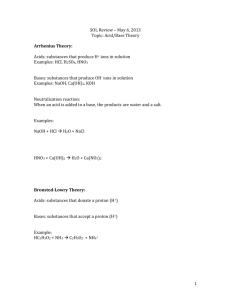
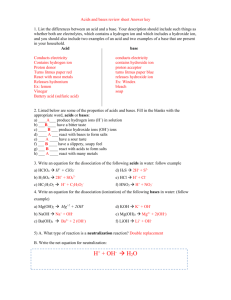
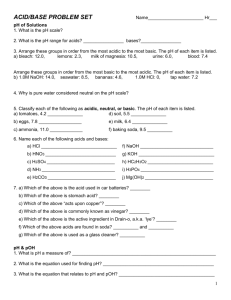
![CHEM 1520 SI MON, TUES, & WEDNES 1.Calculate [H3O+] in a](http://s3.studylib.net/store/data/007346334_1-b78d73402f58153c92290299886ff084-300x300.png)

